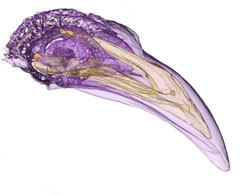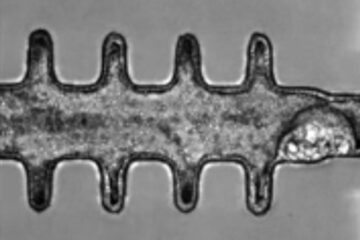Magnetic navigation – putting the cat among the pigeons

A high resolution MRI (magnetic resonance image) of the pigeon beak, showing the area in which the IMP-team searched for magnetic neurons, but instead found iron-rich macrophages. Copyright: Johannes Riegler, UCL<br>
However, research published today in Nature shows that this is not the case. The study shows that iron-rich cells in the pigeon beak are in fact specialised white blood cells, called macrophages. This finding, which shatters the established dogma, puts the field back on course as the search for magnetic cells continues.
“The mystery of how animals detect magnetic fields, has just got more mysterious” said Dr David Keays who led the study. Dr Keays’s lab, based at the Research Institute of Molecular Patholgy (IMP) in Vienna, worked together with Dr Shaw from the University of Western Australian and Dr Mark Lythgoe from the UCL Centre for Advanced Biomedical Imaging. Together they employed state-of-the-art imaging techniques to visualise and map the location of iron rich cells in the pigeon beak.
“We had hoped to find nerves with magnetic crystals” said Dr Keays “but unexpectedly we found thousands of macrophages, each filled with tiny balls of iron.” Macrophages are a type of white blood cell that play a vital role in defending against infection and re-cycling iron from red blood cells, “but they’re unlikely to be involved in magnetic sensing“ explained Dr Keays.
The search for the actual mechanism that allows migratory birds, and many other animals, to respond to the Earth's magnetic field and navigate around their environment remains an intriguing puzzle to be solved.
“We have no idea how big the puzzle is or what the picture looks like, but today we’ve been able to remove those pieces that just didn’t fit“ said Dr Keays.
Media Contact
More Information:
http://www.imp.ac.atAll latest news from the category: Life Sciences and Chemistry
Articles and reports from the Life Sciences and chemistry area deal with applied and basic research into modern biology, chemistry and human medicine.
Valuable information can be found on a range of life sciences fields including bacteriology, biochemistry, bionics, bioinformatics, biophysics, biotechnology, genetics, geobotany, human biology, marine biology, microbiology, molecular biology, cellular biology, zoology, bioinorganic chemistry, microchemistry and environmental chemistry.
Newest articles

Solving the riddle of the sphingolipids in coronary artery disease
Weill Cornell Medicine investigators have uncovered a way to unleash in blood vessels the protective effects of a type of fat-related molecule known as a sphingolipid, suggesting a promising new…

Rocks with the oldest evidence yet of Earth’s magnetic field
The 3.7 billion-year-old rocks may extend the magnetic field’s age by 200 million years. Geologists at MIT and Oxford University have uncovered ancient rocks in Greenland that bear the oldest…

Mini-colons revolutionize colorectal cancer research
As our battle against cancer rages on, the quest for more sophisticated and realistic models to study tumor development has never been more critical. Until now, research has relied on…





















